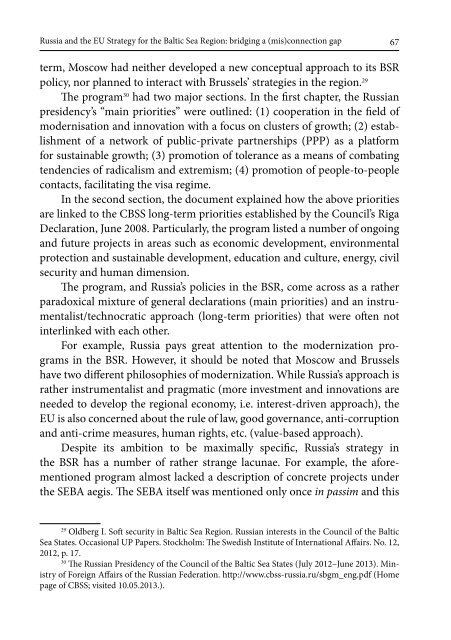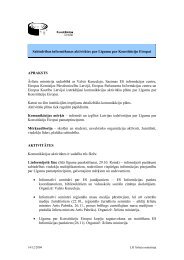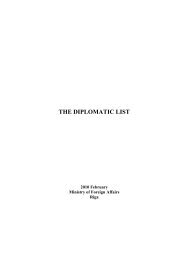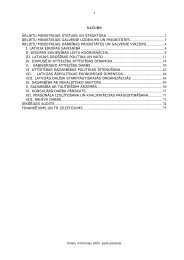Nr.2(10) / 2013.gada jūnijs - Par es.gov.lv
Nr.2(10) / 2013.gada jūnijs - Par es.gov.lv
Nr.2(10) / 2013.gada jūnijs - Par es.gov.lv
You also want an ePaper? Increase the reach of your titles
YUMPU automatically turns print PDFs into web optimized ePapers that Google loves.
Russia and the EU Strategy for the Baltic Sea Region: bridging a (mis)connection gap 67term, Moscow had neither developed a new conceptual approach to its BSRpolicy, nor planned to interact with Brussels’ strategi<strong>es</strong> in the region. 29The program 30 had two major sections. In the first chapter, the Russianpr<strong>es</strong>idency’s “main prioriti<strong>es</strong>” were outlined: (1) cooperation in the field ofmodernisation and innovation with a focus on clusters of growth; (2) <strong>es</strong>tablishmentof a network of public-private partnerships (PPP) as a platformfor sustainable growth; (3) promotion of tolerance as a means of combatingtendenci<strong>es</strong> of radicalism and extremism; (4) promotion of people-to-peoplecontacts, facilitating the visa regime.In the second section, the document explained how the above prioriti<strong>es</strong>are linked to the CBSS long-term prioriti<strong>es</strong> <strong>es</strong>tablished by the Council’s RigaDeclaration, June 2008. <strong>Par</strong>ticularly, the program listed a number of ongoingand future projects in areas such as economic development, environmentalprotection and sustainable development, education and culture, energy, civilsecurity and human dimension.The program, and Russia’s polici<strong>es</strong> in the BSR, come across as a ratherparadoxical mixture of general declarations (main prioriti<strong>es</strong>) and an instrumentalist/technocraticapproach (long-term prioriti<strong>es</strong>) that were often notinterlinked with each other.For example, Russia pays great attention to the modernization programsin the BSR. However, it should be noted that Moscow and Brusselshave two different philosophi<strong>es</strong> of modernization. While Russia’s approach israther instrumentalist and pragmatic (more inv<strong>es</strong>tment and innovations areneeded to develop the regional economy, i.e. inter<strong>es</strong>t-driven approach), theEU is also concerned about the rule of law, good <strong>gov</strong>ernance, anti-corruptionand anti-crime measur<strong>es</strong>, human rights, etc. (value-based approach).D<strong>es</strong>pite its ambition to be maximally specific, Russia’s strategy inthe BSR has a number of rather strange lacunae. For example, the aforementionedprogram almost lacked a d<strong>es</strong>cription of concrete projects underthe SEBA aegis. The SEBA itself was mentioned only once in passim and this29Oldberg I. Soft security in Baltic Sea Region. Russian inter<strong>es</strong>ts in the Council of the BalticSea Stat<strong>es</strong>. Occasional UP Papers. Stockholm: The Swedish Institute of International Affairs. No. 12,2012, p. 17.30The Russian Pr<strong>es</strong>idency of the Council of the Baltic Sea Stat<strong>es</strong> (July 2012–June 2013). Ministryof Foreign Affairs of the Russian Federation. http://www.cbss-russia.ru/sbgm_eng.pdf (Homepage of CBSS; visited <strong>10</strong>.05.2013.).
















